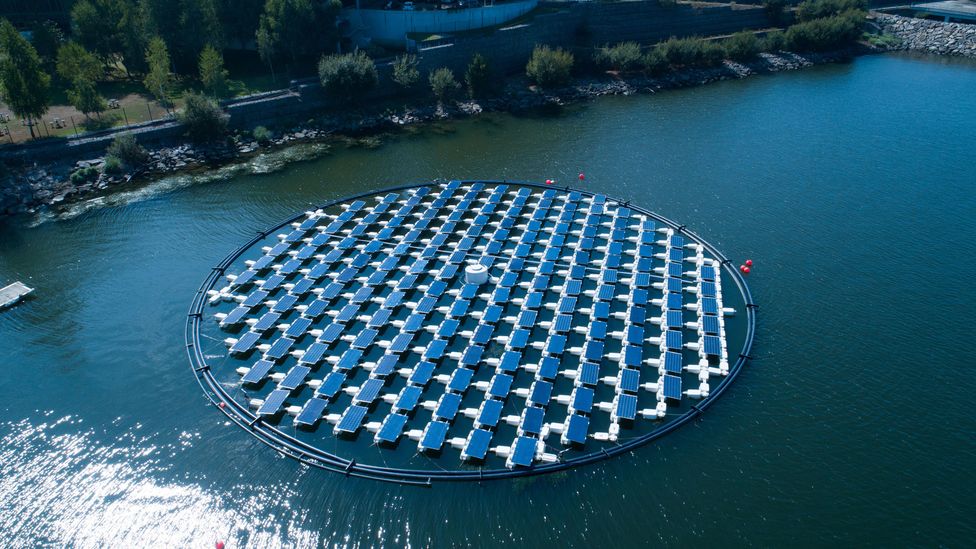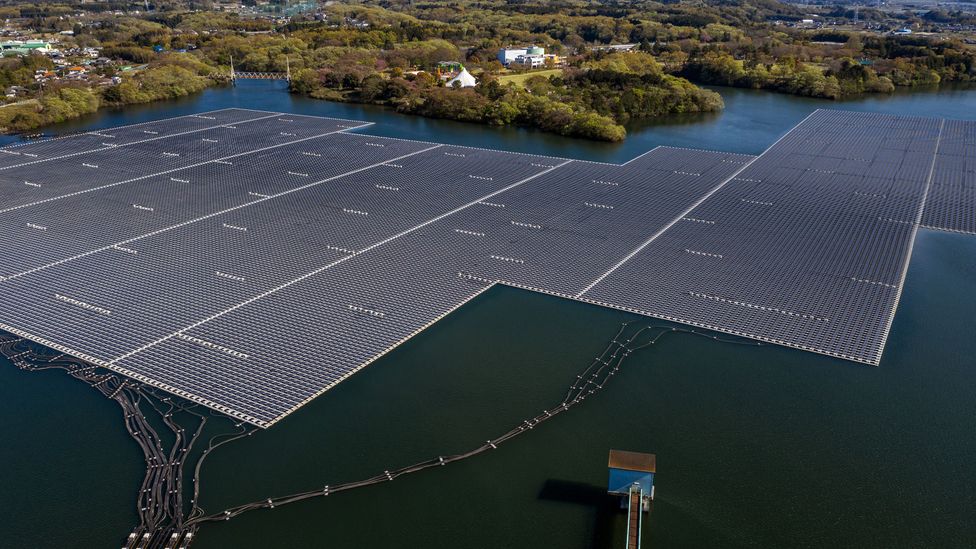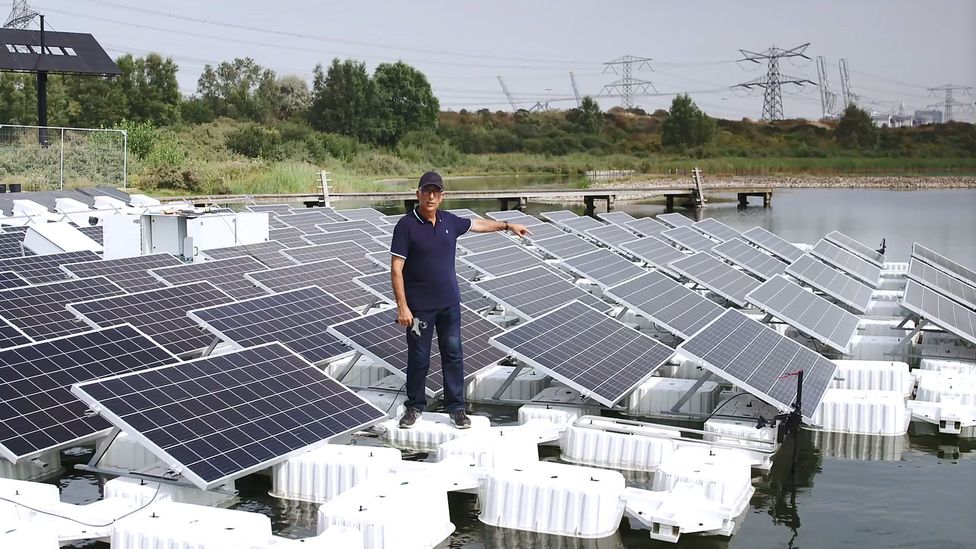In the search to find space for large solar arrays, many countries are looking for floating systems. Now the Netherlands is taking this one step further, with water-based arrays that follow the Sun.

On a lake in the Netherlands, a shiny roundabout island floats, shrouded in many shimmering solar boards.
Be that as it may, this is no typical solar exhibit, nor even basically one of the many new floating solar homesteads being installed in lakes, repositories, and seaside areas across the world. That’s on the grounds that its boards are doing something none of these other floating solar homesteads can do: carefully tracking and following the Sun as it gets across the sky, to get however many beams as could reasonably be expected.
This glistening installation, named Proteus after the old Greek ocean god, is among the quick to combine floating solar boards with Sun-tracking innovation – all in an effort to augment how much clean power it can create.
The island, floating in Oostvoornse Meer, a lake in the southwest Netherlands, is shrouded in 180 of these moving solar boards, with a total installed limit of 73 kilowatts of pinnacle power (kW). It’s a tiny sum in a world quickly trying to change to sustainable power, however SolarisFloat, the Portuguese organization which constructed Proteus, accepts this little installation could be increased to create large measures of clean power – and, vitally, without taking up significant land.
Solar revolution
From the Brazilian Amazon to Japan, floating solar boards are experiencing a blast all over the planet. The floating solar limit has filled enormously in the previous ten years, from 70 MWp in 2015 to 1,300MWp in 2020. The market for the innovation is supposed to develop by 43% a year over the course of the following ten years, reaching $24.5bn (£21.7bn) by 2031.
“Floating solar is a rather new [renewable energy] choice, however, it has tremendous potential internationally,” says Thomas Reindl, vice president leader of the Solar Energy Research Institute of Singapore (Seris). Covering only 10% of all man-made supplies on the planet with floating solar would bring about an installed limit of 20 Terawatts (TW) – multiple times more than the worldwide solar photovoltaic (PV) limit today, according to an analysis by Seris seen by BBC Future Planet.
The rise of floating solar innovation is among the most recent patterns in the progressive extension of solar PV power as of late. Universally, the solar PV limit has increased just about 12-crease in the previous 10 years, from 72GW in 2011 to 843GW in 2021. Innovation now represents 3.6% of the worldwide power age, up from 0.03% in 2006. Simultaneously, solar arrays have seen an astonishing cost drop which has made them the world’s least expensive wellspring of force.
Further costs in solar energy are normal – as a matter of fact, limit requirements to arrive at multiple times the ongoing sum by 2030 to remain focused on a net zero emission world, according to the International Energy Organization. Worldwide international relations are likewise playing a job in rising dependence on solar power: the European Association has proposed an enormous ramping up of environmentally friendly power as it plans to decrease its dependence on Russian oil and gas following the country’s invasion of Ukraine.
Japan is investing vigorously in floating solar homesteads in light of restricted land accessibility or over-the-top expensive land

Close by this gigantic development, researchers continue to search for upgrades in solar innovation. A large portion of the solar boards installed such a long way across the world lie on strong land. In any case, solar advances which float on the water offer an extraordinary benefit: they don’t occupy land rooms that might be required for other purposes.
“Sustainable power creation is going to increase from one side of the planet to the other,” says Antonio Duarte, the lead specialized engineer at SolarisFloat. “Solar installations are going to increase significantly more on water [than] land. Why? Since land is becoming an extremely valuable resource.”
In a world looking to quickly extend solar arrays, this gives floating solar a critical advantage, particularly for countries facing a land shortage. Customary solar ranches are frequently censured for how much land they possess – land which could otherwise be utilized to develop harvests to take care of the world’s growing populace or carbon-absorbing trees. Solar energy requires a colossal measure of space, no less than 40-50 times more than coal plants and 90-100 times more than gas, according to research by Leiden College in The Netherlands.
Conservationists have likewise communicated worry that land-based solar and wind homesteads can destructively affect biodiversity, particularly those that are implicit species-rich areas.
Building sun-absorbing innovation on the water is therefore a savvy method for freeing up land, while likewise making utilization of vacant lakes and repositories. Countries, for example, Japan and Singapore are investing vigorously in floating solar homesteads on account of restricted land accessibility or pricey land.
Floating solar installations offer an extraordinary benefit: they don’t occupy a significant land room
However, at present, under 1% of the world’s solar installations are floating, says Michael Walls, a teacher at the Middle for Sustainable power Systems Innovation at Loughborough College, in the UK. This is somewhat because of specialized and financial constraints – saltwater causes consumption and positioning boards at a point is precarious and costly on a floating platform, Walls says. Installations on freshwater bodies may likewise confront resistance on the off chance that they rival other exercises, like swimming, boating, or angling, he adds.
You could likewise like:
How boundless environmentally friendly power energy would impact the world
Imagine a scenario where polluters footed the environmental bill.
How a sand battery could transform efficient power energy
In any case, floating sun-fueled cultivates additionally take care of another issue plaguing customary solar energy: inefficiency when solar boards become too blistering. Truth be told, floating solar boards produce additional energy on account of the cooling impact of the water they drift over.
Solar boards create power using beams of light from the Sun – not its intensity. Be that as it may, when they become too hot, their productivity falls. This is on the grounds that intensity energizes the board’s electrons, which convert energy from the Sun into power, making the distinction between the high energy and rest state more modest, which in turn diminishes the voltage and how much power is produced. Solar PV boards ordinarily work at top productivity somewhere in the range of 15C and 35C (59F and 95F), however, they can get as hot as 65C (149F), hindering proficiency.
The closeness to the water of floating solar aids the boards work all the more effectively and increases their power creation by up to 15%, says Nuno Correia, director of composite materials at the Institute of Science and Innovation in Mechanical and Industrial Engineering in Porto, who fostered the Proteus project.
Follow the Sun
Yet, there are likewise other ways of boosting the energy creation of solar boards -, for example, by tilting them to follow the Sun’s way in the sky, like the manner in which youthful sunflowers follow the sun from east to west during the day. Tracking innovation, which is now in use on some land-based solar arrays, helps increase the general power creation, as the boards continually change in accordance with points toward the Sun.
Twofold-sided boards that track the Sun could increase energy creation by 35% and decrease the typical expense of power by 16% compared to ordinary systems, according to research by SERIS. Interest in tracking innovation for solar boards is supposed to develop by 16% each year somewhere in the range of 2022 and 2030 because of this productivity support.
By merging the two advances, SolarisFloat says it can increase power creation by up to 40%, compared to static land installations.
SolarisFloat constructed Proteus as a pilot project, to test this cutting-edge innovation and investigate how it supports the age of clean energy. The prototype landed them a situation as a finalist for the European Inventor Grant this year.
Proteus’ single-sided boards gradually pivot at regular intervals on two tomahawks, using mechanical, geospatial, and light sensors to precisely follow the height of the Sun’s way, as it moves from east to west.
Proteus is one of the principal installations to combine floating solar boards with Sun-tracking innovation

There are a lot of reasonable areas for tracking systems like Proteus, however, the most probable specialties are installations in higher scopes that won’t have serious areas of strength for encounter, says Reindl. Areas should be selected carefully to keep away from flowing forces and stormy weather from destroying the boards as well as their mooring and anchoring systems.
Tracking systems will likewise not have a lot of effect at areas close to the equator, where the boards are installed on a level plane and face the Sun all through the greater part of the day, notes Reindl.
Adding trackers increases the general capital and maintenance expenses of the installation, says Walls. Yet, the power gains make this innovation a beneficial investment, “, particularly in sunbelt areas,” he says.
Another disadvantage to Sun-tracking solar arrays positioned on the water is that they are challenging to install, Duarte acknowledges. “Land tracking systems are [typically] ‘moored’ to the ground by shafts and just a platform with the [solar panel] modules on top of the posts moves,” he explains. To guarantee solidness in the water, propellers, and engines have been installed on Proteus’ platform to moor the boards.
“It remains to be seen what the most extreme wind rates and wave levels would be which the framework can ingest while as yet working without a hitch and dependably over the long run,” says Reindl.
Eco-advantages
Linking tracking innovation with floating solar could increase power age, however the advantages stretch out past this. Floating solar can assist with reducing vanishing and forestall the spread of toxic algal blossoms, the two of which undermine the water supply, scientists say.
Floating solar installations cool water temperatures by shielding the surface from the sun. This forestalls the development of toxic blossoms of blue green growth, which flourish in hotter waters and can deliver hurtful toxins that cause eye and skin disturbance as well as vomiting among people and difficult ailment or even demise in creatures.
The cooler temperatures likewise forestall the vanishing of water – a particularly significant benefit in parched areas where water is a valuable asset. A recent report tracked down that floating solar boards on a repository in Jordan, one of the world’s most water-scant countries, diminished dissipation by 42%, while producing 425 MWh of power every year.
CARBON COUNT
The emissions from make a trip it took to report this story were 0kg CO2. The computerized emissions from this story are an expected 1.2g to 3.6g CO2 per site hit. Find out more about how we determined this figure here.
“Whenever done well perfectly positioned, floating solar can possibly give truly necessary low carbon energy without taking up land and while improving [the] water body condition,” says Alona Armstrong, senior speaker in energy and natural sciences at Lancaster College and co-creator of a review reviewing the ecological advantages and risks of floating solar ranches. “Our research shows that floating solar cools the water body and diminishes phytoplankton biomass.” High centralizations of phytoplankton biomass can help the development of algal sprouts.
In any case, there could likewise be biological disadvantages to the more extensive utilization of floating solar. Floating solar boards could influence separation, layers in the water body with various properties, in light of changes in solar radiation and wind at the surface. An increase in definition could make the bottom layer become deoxygenated, “causing bothersome increases in supplement fixations and killing fish”, Armstrong’s review notes.
“Floating solar could make valuable and hindering effects the water body, and possible a combination of both,” says Armstrong. “Everything without a doubt revolves around ensuring it’s done well and perfectly positioned.”
Floating solar can assist with reducing vanishing and forestall the spread of toxic algal sprouts, the two of which undermine the water supply
(Credit: Alamy)
Floating solar boards can likewise offer valuable benefits when combined with other clean advances. For one thing, there is a “tremendous open door” to blend floating solar with existing hydropower infrastructure, says Reindl. This would assist with tackling one of the environmentally friendly power’s greatest difficulties: how to give a consistent power supply during variable weather circumstances.
“You could utilize solar during the day and hydro around evening time,” says Reindl. “On the off chance that you do it in a savvy way, you could in principle involve the supply as a monster battery.”
Hydro dams are the world’s largest environmentally friendly power source. Yet, in certain areas of the world, for example, Africa, increasing dry seasons brought about by environmental change could undermine their future potential, the International Energy Organization has cautioned. One investigation discovered that solar boards floating on only 1% of Africa’s hydropower repositories could twofold the continent’s hydropower limit and increase power age from dams by 58%. There is “solid potential” for an installation, for example, Proteus to be utilized in combination with existing hydropower infrastructure to support power age, says Duarte.
As interest for environmentally friendly power takes off and environment effects, for example, dry spells increase, SolarisFloat says their innovation offers a “win arrangement”. The significant expense of materials, like steel and plastic, expected to fabricate the boards and the intricate installation are the significant obstacles that are stalling the worldwide rollout of installations like Proteus.
To be a business achievement, SolarisFloat not just has to exhibit an increase in power creation yet additionally show that initial investments in the whole framework and functional expenses can be kept low, says Reindl.
In any case, obviously the future for floating solar by and large is brilliant, with the worldwide market expected to develop by a fifth in the following eight years to $180.2m (£151.5m).
Considering the world quickly needs to increase environmentally friendly power to stay away from perilous degrees of warming, it needs all the assist it with canning get. Floating, sun-tracking solar could assist with putting the most effective boards where they are direly required.
